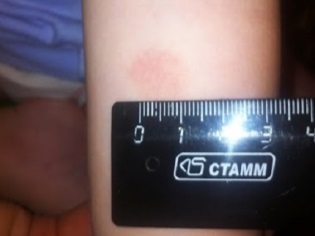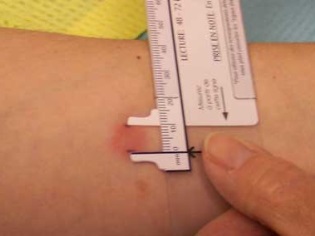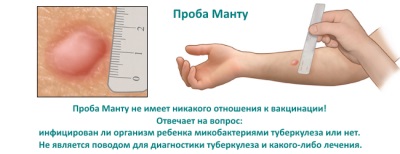The reaction to the Mantoux test in a child
The Mantoux test should not be confused with vaccinations, since this is not a vaccination, but a special skin test, the results of which help to reveal infection with tuberculosis. What else should parents know about this test and how to act with a positive Mantoux reaction?
How it works?
The essence of this test is the introduction of child tuberculin - a drug made from mycobacterial tuberculosis. At the injection site, a local reaction begins, according to which they evaluate whether the organism is familiar with tubercle bacilli or not.
If the crumbs of mycobacteria have already entered the body, lymphocytes are produced in response to their penetration. It is these blood cells that will cause the skin to react in the place where tuberculin is injected.
pros
Thanks to the Mantoux test, you can:
- Early detection of tuberculosis in children.
- Determine whether vaccination is needed, as well as revaccination against tuberculosis.
Minuses
The effectiveness of the test is not always reliable, as it is influenced by the characteristics of storage and transportation of tuberculin, errors in the injection or counting, the presence of allergic and chronic diseases, skin sensitivity, air humidity, the use of medicines and other factors. Also, the test can cause allergies, fever, loss of appetite, weakness, skin rash.
Opinion E. Komarovsky
The famous pediatrician considers the Mantoux test as an important diagnostic test that every child should carry out. He is confident that with such a prevalence of tuberculosis, which is celebrated in our day, it is not safe to refuse Mantu.
For more on this, see Dr. Komarovsky’s program.
How to make an injection?
Tuberculin in a dose of two units (0.1 ml of solution) is administered intracutaneously to children in the arm in the middle of the forearm area. The first test is carried out at 12 months and is repeated every year (usually in the autumn time). Hand during the next test change.
If the baby has not been vaccinated with BCG vaccine or has no scar left after such a vaccination, the Mantoux test is performed twice a year. It should be carried out before any vaccination. If the child has only been vaccinated against any infection, it is necessary to wait at least 1 month before the test. After a blood transfusion, Mantoux can only be delivered in two weeks.
Results analysis
Sample results are evaluated on the third day - after 72 hours. In the state. Institutions often do the sample on Friday, and the result is estimated on Monday.
First of all, two variants of the reaction are taken into account:
- The appearance of hyperemia (the injection site turns red).
- The appearance of the papule (the injection site becomes dense and rounded).
Both hyperemia and papule are measured using a transparent ruler, and their severity is also assessed. First of all, it is important to evaluate papule - the ruler is applied transversely to the arm and change the diameter of the seal in millimeters. The sizes of a hyperemia are estimated only in the absence of papules.
The reaction may be:
- Negative. No changes on the skin of the child is detected.
- Doubtful. A papule from 2 to 4 mm has appeared, or there is no papule, but there is a hyperemia of any size.
- Positive. Such a reaction, depending on the diameter of the papule that appeared, is considered mild (5-9 mm), medium-intensity (10-14 mm) and pronounced (15-16 mm).
- Excessive. If the diameter of the papule formed is more than 17 mm or a reaction of the lymph nodes is noted, papule ulceration and other signs of inflammation have appeared. This reaction is also called hyperergic.
Upon receipt of a dubious result, a child can be sent for blood and urine tests, and parents can undergo FG examinations. After registration on the "turn" (the results of the sample are taken into account in the dynamics - the current year compared to the previous result), the TB doctor may order a chest X-ray and Diaskintest.
On the basis of the joint venture 3.1.2.3114-13 "Prevention of tuberculosis" dated 22.10.2013 Children who have not submitted a phthisiatric tuberculosis conclusion are not allowed into children's organizations. Such an opinion must be provided within 1 month from the moment the child was given a Mantoux test.
Can I swim after a Mantoux test?
You can wash the baby after the Mantoux test, but you should not scratch and rub the injection site. It is also prohibited to glue the adhesive tape in place, smear it with any disinfecting solution or bandage.
Tips not to swim after Mantoux began to be given at the time of not skin tests, but skin tests. In the past 15 years, all Mantoux tests are carried out with the use of intradermal administration of tuberculin, and water does not enter the skin during bathing.
But practice shows that when taking a bath, the result of a Mantoux test may turn out to be uninformative, especially if the child still scratches or rubs the place of the injection with a washcloth. That is why we advise to refrain from such water procedures. Washing the child before removing the results will be quite enough.

What if the reaction is positive?
If the test result is negative, it means that the child’s body did not encounter mycobacterium tuberculosis and did not get sick, but did not develop immunity to them.
A questionable result is equated to a negative one or, if necessary, additional examinations are prescribed.
But a positive reaction may indicate both the presence of immunity and infection.
If earlier the Mantoux test was negative or the papule size increased by 6 millimeters or more in relation to the previous one, such a situation is called a “turage of the tuberculin test”. Virage, the presence of an overreaction, as well as the long-term preservation of a medium-intensity sample (the diameter of the papule exceeds 12 mm for more than four years) are considered signs of infection with tuberculosis.
At the same time, only Mantoux cannot be diagnosed; therefore, if a child is infected with tuberculosis, it is necessary to examine him further. First, a sample will be performed again at the tuberculosis dispensary, and then they will conduct an examination and prescribe additional tests.
Failure of the procedure
Many parents mistakenly include the Mantoux test for vaccinations, so quite often they want to refuse it.
But even those who distinguish Mantoux from vaccination may refuse due to the delusion of the danger of the drug, since the solution contains phenol. It is indeed a toxic substance, but its dose is extremely small and cannot have a toxic effect.
However, if parents are confident that they want to give up Mantoux for their children, they have such a right. Refusal to make out in writing according to the sample, which is issued in the clinic. However, they must understand all the risks of such a failure.
Is there an alternative?
There is a method that, like Mantoux, determines the presence of a tuberculosis disease. He is called Diaskintest.The test is also carried out intracutaneously and its results are measured, and the reaction to this test will be only if there are active mycobacteria in the body, as it contains mycobacterial proteins that cause tuberculosis in humans and does not contain the proteins of the mycobacterial vaccine strain introduced to the child during BCG vaccination .
But, since Diaskintest will not show whether there is immunity to tuberculosis, they should not replace the Mantoux test, but it is worth using this test only as a supplement that helps confirm the progression of the disease. Such a test will not help to determine whether the BCG is still active or a child at the age of 7 needs a new vaccination. In addition, about 5-8% of children become infected with bovine-type mycobacteria, to which Diaskintest does not respond.
Another alternative to Mantu can be called a child's blood test for the presence of antibodies to mycobacteria. Such an analysis is offered in private medical laboratories.
Tips
- You should not give antihistamines to your child before the test, because they can affect the assessment of results.
- Limit in the child's menu foods that may cause an allergic reaction, such as chocolate and citrus.
You can learn more about the Mantoux reaction in the following videos.

















